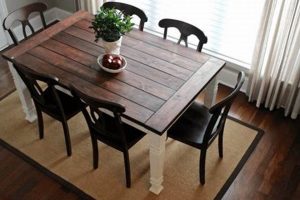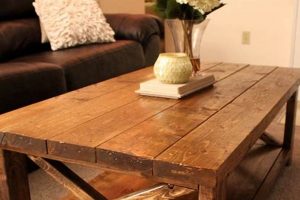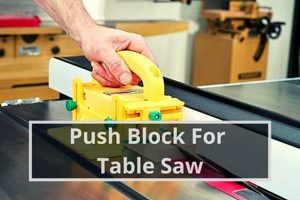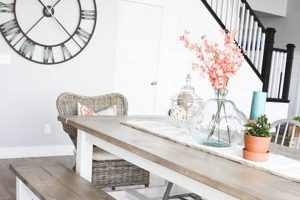The act of constructing outdoor furniture oneself, specifically tables designed for patios, constitutes a popular approach to home improvement and customization. These projects range from simple repurposing of existing materials to more complex builds requiring woodworking skills and specialized tools. Examples include tables crafted from reclaimed wood pallets, repurposed cable spools, or concrete and mosaic tile combinations.
Creating these outdoor furnishings offers several advantages. It provides cost savings compared to purchasing new furniture, allows for tailored designs to match individual aesthetic preferences and spatial constraints, and promotes environmental sustainability through the reuse of materials. Historically, self-built furniture has been a common practice, particularly during times of economic hardship or in communities with limited access to commercial products.
The subsequent sections will explore various project options, material considerations, construction techniques, and finishing processes relevant to creating customized outdoor tables for enhanced patio enjoyment. These considerations encompass both aesthetic appeal and functional durability in outdoor environments.
Construction Recommendations
The following guidelines provide valuable insight for successful implementation and prolonged usability of self-constructed outdoor tables.
Tip 1: Material Selection: Choose materials appropriate for outdoor conditions. Consider weather resistance, durability, and potential for degradation from sunlight, moisture, and temperature fluctuations. Treated lumber, naturally rot-resistant woods like cedar or teak, and powder-coated metal are preferable.
Tip 2: Structural Integrity: Prioritize robust construction techniques. Ensure stable connections between table components using appropriate fasteners (screws, bolts) and joinery methods (mortise and tenon, dovetails). Reinforce weak points with additional supports.
Tip 3: Surface Treatment: Apply a protective finish to the tabletop. Sealants, stains, and exterior-grade paints shield the surface from moisture, UV damage, and abrasions. Reapply finish periodically to maintain protection.
Tip 4: Ergonomic Considerations: Determine appropriate table height and size based on intended use and seating arrangements. Standard dining table heights range from 28 to 30 inches. Allow adequate legroom and surface space for comfortable use.
Tip 5: Weight and Portability: Balance stability with ease of movement. Design the table with a manageable weight if relocation is required. Consider incorporating wheels or casters for increased portability.
Tip 6: Drainage and Water Management: Prevent water accumulation on the tabletop by incorporating a slight slope or drainage channels. This minimizes the risk of warping, cracking, and rot.
Tip 7: Safety Precautions: Employ appropriate safety measures during construction. Wear safety glasses, gloves, and respiratory protection when cutting, sanding, or applying finishes. Follow manufacturer’s instructions for power tools and adhesives.
Adhering to these guidelines during design and construction will result in a functional, durable, and aesthetically pleasing addition to the patio environment. Prior planning prevents premature failure.
These tips should be regarded as preliminary guidance, further research and tailored adaptations based on the specific project are essential to secure success and security.
1. Material Durability
The longevity and sustained functionality of a self-constructed patio table are inextricably linked to the inherent durability of the chosen materials. The outdoor environment presents a range of challenges, including exposure to ultraviolet radiation, fluctuating temperatures, precipitation, and humidity, all of which can contribute to material degradation. The selection of inherently durable materials or those capable of being treated to enhance their resistance to these elements is, therefore, a primary determinant of a successful outcome. For example, untreated softwood exposed to persistent moisture will rapidly decay, compromising the structural integrity of the table, while naturally rot-resistant hardwoods like teak or cedar exhibit extended lifespans in similar conditions.
Furthermore, the implications of inadequate material durability extend beyond structural failure. Cosmetic damage, such as fading, cracking, or staining, can detract from the aesthetic appeal of the table, diminishing its value as a functional and decorative element of the patio. Appropriate selection involves understanding the specific properties of various materials, including their resistance to rot, insect infestation, weathering, and physical impact. In the realm of metalwork, for example, powder-coated aluminum or galvanized steel offer superior corrosion resistance compared to untreated steel, preventing rust and maintaining structural soundness. Reclaimed materials may be viable but must undergo thorough inspection and treatment to mitigate existing degradation.
In summary, material durability represents a critical consideration when undertaking an outdoor table construction project. The investment in durable materials, coupled with appropriate protective treatments, translates directly to increased lifespan, reduced maintenance requirements, and sustained aesthetic value. Neglecting this aspect often results in premature failure, necessitating costly repairs or complete replacement, ultimately negating the initial cost savings associated with self-construction. Therefore, a comprehensive understanding of material properties and their interaction with the outdoor environment is essential for achieving a sustainable and functional result.
2. Structural Stability
Structural stability, in the context of self-constructed outdoor tables, refers to the ability of the table to withstand applied loads and environmental forces without undergoing excessive deformation or catastrophic failure. It is a paramount consideration in the design and construction phases, directly impacting the safety, longevity, and usability of the finished product. Inadequate attention to structural stability can result in wobbly tables, component breakage, and ultimately, rendering the table unusable or even hazardous.
- Joint Integrity
Joints represent critical points of connection between various table components. The selection and execution of appropriate jointing techniques are essential for transferring loads effectively and preventing premature failure. Examples include mortise and tenon joints, dovetail joints, and bolted connections. Inadequate joint design or improper execution can lead to joint separation under load, resulting in instability and potential collapse. For instance, a poorly executed mortise and tenon joint in a table leg can cause the leg to detach under moderate weight, compromising the entire structure.
- Load Distribution
The design should ensure that applied loads are evenly distributed throughout the table structure. Concentrated loads, such as heavy objects placed on a specific area, can create stress points that exceed the material’s capacity, leading to deformation or fracture. Reinforcement techniques, such as adding support beams or aprons, can distribute loads more effectively, enhancing overall stability. A table with a large unsupported tabletop area may sag under the weight of several dishes, whereas a table with strategically placed support beams will maintain a level surface.
- Material Properties
The inherent strength and stiffness of the chosen materials play a crucial role in structural stability. Materials with higher strength and stiffness can withstand greater loads and resist deformation. For example, a table constructed from hardwood is generally more stable than one constructed from softwood due to the higher density and compressive strength of hardwood. The selection of appropriate materials must consider the anticipated loads and environmental conditions to ensure long-term stability.
- Foundation and Leveling
Even the most well-constructed table will be unstable if placed on an uneven surface. Proper leveling and a stable foundation are essential for maintaining structural integrity. Uneven surfaces can induce torsional stresses that weaken joints and compromise overall stability. Adjustable feet or shims can be used to level the table on uneven ground, ensuring a stable and safe platform for use. A table placed on a sloping patio may wobble and be prone to tipping, whereas a leveled table provides a secure and comfortable surface.
These facets highlight the interconnectedness of design, material selection, and construction techniques in achieving adequate structural stability in self-constructed outdoor tables. Addressing each of these aspects with careful consideration will result in a durable, safe, and enjoyable addition to any patio environment. Ignoring these principles will likely result in a short-lived and potentially dangerous piece of furniture.
3. Design Aesthetics
Design aesthetics, in the context of constructing outdoor tables, represents a crucial element influencing the perceived value and user satisfaction derived from the finished product. The visual appeal of a self-built patio table directly impacts its integration into the surrounding outdoor environment, enhancing or detracting from the overall aesthetic of the patio or garden space. A well-designed table complements the existing architectural style, landscaping, and other outdoor furnishings, creating a cohesive and visually pleasing atmosphere. Conversely, a poorly designed table can appear out of place, diminishing the aesthetic value of the entire outdoor area. The choice of materials, the table’s form, the integration of decorative elements, and the applied finish all contribute to its overall aesthetic impact.
The application of design principles, such as proportion, balance, rhythm, and harmony, is essential in achieving a visually appealing result. For instance, a table with overly bulky legs in relation to its tabletop may appear unbalanced, while a table with repetitive decorative patterns can create a sense of rhythm and visual interest. Furthermore, the choice of materials should align with the desired aesthetic. Reclaimed wood with visible weathering can impart a rustic and natural look, while sleek metal and glass combinations convey a more modern and contemporary feel. Color selection also plays a significant role; natural wood tones often blend seamlessly with outdoor settings, whereas vibrant colors can add a pop of visual interest. Successful design often involves a careful consideration of these factors and a thoughtful integration of aesthetic elements to create a harmonious and visually pleasing outcome.
Ultimately, the incorporation of design aesthetics into self-constructed outdoor tables transforms a functional object into a decorative element that enhances the enjoyment and visual appeal of the patio environment. While structural integrity and durability remain paramount, the aesthetic considerations should not be overlooked. A well-designed table not only provides a functional surface but also serves as a reflection of the owner’s personal style and enhances the overall ambiance of the outdoor space. Balancing practicality with visual appeal is key to a successful outcome, ensuring that the table is both functional and aesthetically pleasing for years to come.
4. Weather Resistance
Weather resistance is a critical determinant of the long-term viability of self-constructed patio tables. The direct exposure to environmental elements necessitates careful consideration of material selection and protective finishing techniques to mitigate degradation and ensure sustained functionality. Absent adequate weather resistance, even structurally sound tables will succumb to damage, reducing their lifespan and negating the economic and aesthetic benefits of a do-it-yourself project. For instance, a table constructed from untreated pine will rapidly deteriorate when exposed to rain and sunlight, leading to warping, cracking, and fungal growth. This degradation not only compromises the table’s structural integrity but also renders it aesthetically unappealing.
The implementation of appropriate weather-resistant strategies directly translates to increased durability and reduced maintenance requirements. Selecting naturally weather-resistant materials, such as teak, cedar, or redwood, provides inherent protection against moisture, insect infestation, and decay. Alternatively, the application of sealants, stains, and exterior-grade paints to less resistant materials, such as pressure-treated lumber, creates a protective barrier against environmental damage. Furthermore, design features that promote water runoff, such as sloped surfaces or drainage channels, can prevent water accumulation and minimize the risk of rot and corrosion. An example of this is incorporating gaps between tabletop planks to allow water to drain freely, preventing pooling and subsequent damage. The choice of fasteners, such as stainless steel screws, also contributes to weather resistance by preventing rust and maintaining structural connections over time.
In conclusion, the integration of weather-resistant features is essential for the successful construction of durable and long-lasting patio tables. The selection of appropriate materials, the application of protective finishes, and the incorporation of design elements that mitigate water damage are all crucial considerations. The failure to prioritize weather resistance will inevitably result in premature degradation, compromising the table’s functionality and aesthetic appeal. Therefore, a thorough understanding of weather-resistant materials and techniques is paramount for anyone undertaking a do-it-yourself patio table project. Prior planning and careful execution will significantly extend the table’s lifespan and ensure years of enjoyable use.
5. Cost Efficiency
Cost efficiency, as it pertains to self-constructed patio tables, represents a primary motivator for many individuals undertaking such projects. The economic benefits derive from a reduction in material expenses, labor costs, and the avoidance of retail markups associated with commercially manufactured furniture. However, a comprehensive understanding of cost efficiency requires a nuanced assessment that extends beyond initial expenditures.
- Material Sourcing and Selection
The selection of materials significantly impacts project costs. Reclaimed lumber, repurposed materials (e.g., pallets, cable spools), and discounted construction supplies can substantially reduce expenses compared to purchasing new, premium materials. Careful sourcing involves exploring local salvage yards, online marketplaces, and community resources to identify cost-effective options. The implications extend to material durability; lower initial costs may be offset by reduced lifespan and increased maintenance requirements, ultimately diminishing long-term cost efficiency.
- Tool Investment vs. Rental
Construction frequently necessitates specialized tools. The decision to purchase or rent tools influences overall cost. Purchasing tools represents a long-term investment, benefiting future projects but incurring significant upfront costs. Renting tools provides access to necessary equipment without the long-term financial commitment. Cost-benefit analyses should consider the frequency of tool use and the potential for future projects to determine the most economically sound approach.
- Labor Valuation
Self-construction eliminates external labor costs; however, it necessitates a valuation of the builder’s time. The time invested in design, material acquisition, construction, and finishing represents a significant opportunity cost. Individuals should realistically assess their skill level and time availability, considering the potential for errors, rework, and project delays. Complex designs requiring specialized skills may ultimately prove more costly in terms of time and materials than simpler, commercially available alternatives.
- Longevity and Maintenance Costs
Initial cost savings can be negated by increased maintenance and reduced lifespan. The use of inferior materials or inadequate construction techniques can lead to premature failure, necessitating repairs or replacement. Durable materials and proper finishing techniques extend the table’s lifespan, reducing long-term costs. Regular maintenance, such as cleaning and refinishing, contributes to sustained functionality and minimizes the need for costly repairs. Assessing lifecycle costs provides a more accurate representation of cost efficiency than solely focusing on initial expenditures.
These multifaceted elements underscore the complexity of evaluating cost efficiency in the realm of self-constructed patio tables. A holistic approach that considers material sourcing, tool investment, labor valuation, and lifecycle costs provides a more accurate representation of economic benefits, ensuring that DIY endeavors genuinely deliver superior value compared to commercial alternatives. Projects undertaken without this comprehensive assessment risk compromising quality and long-term savings.
6. Skill Level
The successful execution of “diy patio table ideas” is intrinsically linked to the skill level of the individual undertaking the project. The complexity of the design, the choice of materials, and the required construction techniques all necessitate varying degrees of proficiency in woodworking, metalworking, or related crafts. A mismatch between the project’s demands and the builder’s capabilities can result in compromised structural integrity, aesthetic deficiencies, and ultimately, project failure. Novice builders attempting intricate designs involving complex joinery or specialized finishes may encounter challenges leading to unsatisfactory outcomes, increased material waste, and potentially hazardous situations. Conversely, experienced craftspeople can leverage their skills to create durable, aesthetically pleasing, and customized outdoor tables that surpass commercially available options in quality and design. A simple example is constructing a basic pallet table, which requires minimal skills and tools, compared to a mosaic-tiled table which demands tile-setting expertise.
The correlation between skill level and project success manifests in several tangible ways. Individuals with limited experience should focus on simpler designs, utilizing readily available materials and basic construction techniques. These projects might involve assembling pre-cut lumber, repurposing existing furniture components, or employing straightforward joinery methods like screwing or bolting. As skills progress, builders can gradually tackle more challenging designs incorporating advanced joinery, intricate detailing, or mixed-material construction. For instance, after successfully building several simple tables, an individual might attempt a project involving mortise and tenon joints, custom-cut metal legs, or epoxy resin inlays. The ability to accurately measure, cut, and assemble materials, as well as proficiency in finishing techniques like sanding, staining, and sealing, are all critical skills that influence the final product’s quality and longevity.
In summary, skill level serves as a foundational element in the realm of “diy patio table ideas,” influencing the feasibility, execution, and ultimate success of any project. Recognizing one’s own skill limitations and selecting projects accordingly is crucial for minimizing frustration, maximizing material utilization, and achieving a satisfying and functional outcome. The progression from simpler to more complex projects allows for gradual skill development and fosters a sense of accomplishment, leading to an appreciation for the craft and the creation of personalized outdoor furnishings. The key insight is selecting DIY projects aligning with existing abilities, ensuring a positive and productive experience.
Frequently Asked Questions
The following addresses common inquiries regarding the construction of self-made outdoor tables, offering insights into design, materials, and techniques for ensuring both aesthetic appeal and structural longevity.
Question 1: What constitutes the most durable material for an outdoor table subjected to year-round weather conditions?
Teak, cedar, and redwood exhibit inherent resistance to rot, insects, and moisture, making them suitable choices. Pressure-treated lumber provides an alternative, requiring protective sealing. Metal, particularly powder-coated aluminum or galvanized steel, offers durability but may require precautions to prevent heat absorption in direct sunlight.
Question 2: What is the recommended method for ensuring structural stability in a self-constructed outdoor table?
Robust joint construction is paramount. Mortise and tenon, dovetail, or bolted connections provide secure fastening. Load distribution should be considered, incorporating support beams or aprons to prevent sagging. Proper leveling on the patio surface is essential to mitigate stress on joints.
Question 3: What protective finishes are recommended to enhance weather resistance for wooden outdoor tables?
Exterior-grade sealants, stains, and paints provide a barrier against moisture, UV radiation, and fungal growth. Penetrating oils, such as teak oil, can nourish the wood and prevent cracking. Regular reapplication is necessary to maintain protection.
Question 4: How can design aesthetics be incorporated into self-built outdoor tables without compromising structural integrity?
Design aesthetics should complement structural considerations. Proportion, balance, and harmony are key design principles. Decorative elements, such as inlays or carved details, should be integrated without weakening structural components. Material choices should align with the desired aesthetic, but durability remains paramount.
Question 5: What cost-effective alternatives exist for constructing outdoor tables while maintaining reasonable durability?
Reclaimed lumber, repurposed pallets, and salvaged materials offer budget-friendly options. However, thorough inspection and treatment are necessary to address potential decay or insect infestation. Pressure-treated lumber, though less aesthetically appealing, provides a cost-effective and durable base material.
Question 6: What safety precautions should be observed during the construction of outdoor tables?
Eye protection, gloves, and respiratory protection are essential when cutting, sanding, or applying finishes. Power tools should be used according to manufacturer’s instructions. Adequate ventilation is necessary when working with solvents or adhesives. Secure work surfaces prevent accidents during construction.
In summary, constructing durable and aesthetically pleasing outdoor tables necessitates a balanced approach, prioritizing both structural integrity and weather resistance. Material selection, joint construction, protective finishes, and adherence to safety protocols are integral to a successful outcome.
The subsequent sections will delve into specific design examples and step-by-step construction guides for various outdoor table projects, catering to different skill levels and aesthetic preferences.
Conclusion
The preceding discussion has presented a comprehensive overview of the multifaceted considerations inherent in the execution of “diy patio table ideas”. Key elements, including material durability, structural stability, design aesthetics, weather resistance, cost efficiency, and builder skill level, have been examined to underscore their respective influences on project outcomes. A judicious assessment of these factors is paramount for realizing a functional, aesthetically pleasing, and long-lasting outdoor table.
The information provided serves as a foundational guide for individuals embarking on such projects. Meticulous planning, judicious material selection, and diligent adherence to sound construction principles will not only enhance the probability of success but also contribute to the creation of a customized outdoor furnishing that enriches the patio environment. The creation of durable and stylish outdoor furniture is achievable through thoughtful planning and careful execution.






![Build a Safe DIY Table Saw Push Stick [Guide] The DIY Hub: Creative Crafts, Repairs & Life Hacks Build a Safe DIY Table Saw Push Stick [Guide] | The DIY Hub: Creative Crafts, Repairs & Life Hacks](https://craftingdiycenter.com/wp-content/uploads/2025/07/th-4323-300x200.jpg)
